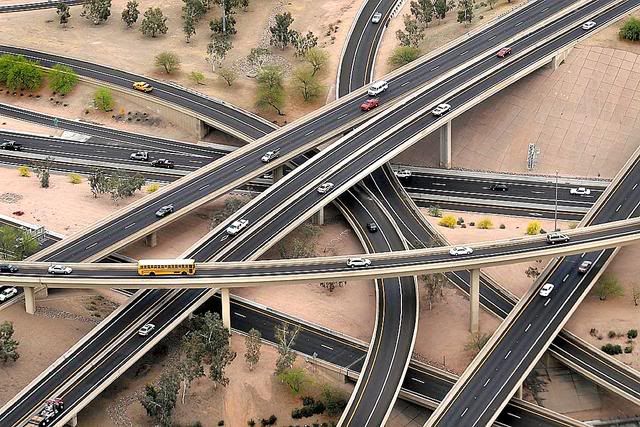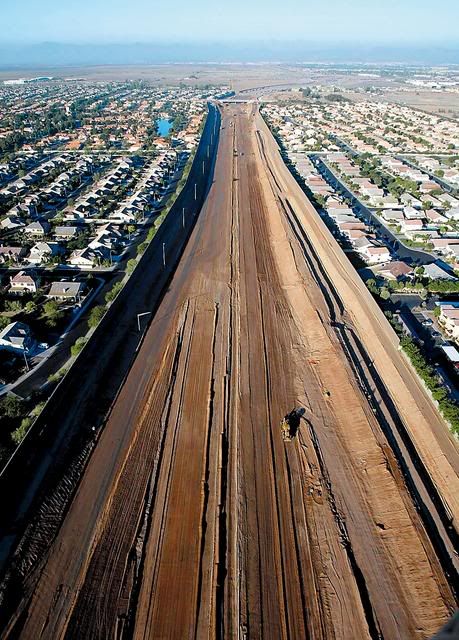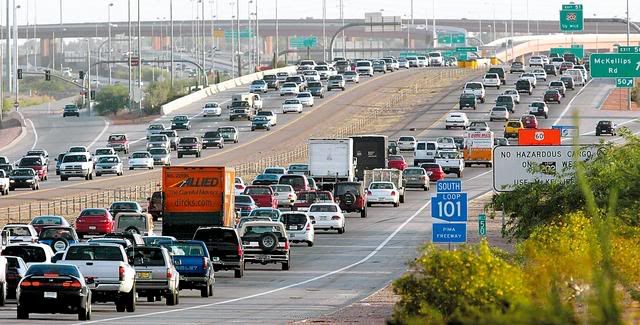With a new transportation plan up for voters' approval next month, Tucson looks at the transportation lessons of Phoenix, as more freeways are no longer the answer they were once thought to be, with construction costs spiraling and revised laws requiring multimodal transportation funding:
Think you might see more of these big Phoenix freeways replicated in Tucson? Think again.
The 202 intersection with the Hohokam Expressway (Arizona 143) near Sky Harbor Airport

Construction on Loop 202 near Alma School Rd., Nov. 2004

Southbound 101 in Scottsdale approaching the interchange with the 202
 Looking north for transit lessons
Looking north for transit lessons
Phoenix happy enough to renew its half-cent tax
By Tim Ellis
ARIZONA DAILY STAR
4.16.2006
PHOENIX — Twenty years after voters here approved plans to build a series of roadways to relieve congestion, and a half-cent sales tax to pay for them, rush-hour traffic still crawls and, in some areas, grinds to a stop. Occasional gridlock notwithstanding, Valley of the Sun voters were happy enough with the results that in 2004 they approved a second 20-year plan.
They also renewed the half-cent-per-dollar sales tax to raise some $16 billion, for two more loop freeways, more lanes and extensions for existing freeway loops and to boost transit, including a 27.7-mile light-rail system. That voter confidence was born of a recognition that Phoenix-area traffic congestion is not as bad as it would have been if they hadn't passed the first 20-year transportation-improvement plan, said Eric Anderson, transportation director for the Maricopa Association of Governments.
With Pima County voters going to the polls next month to decide on their own transportation plan and tax, some may wonder what they can learn from metro Phoenix's last two decades of laying asphalt. There, about 138 miles of loop roads and freeway-like parkways were built under the first 20-year transportation plan, passed in 1985. But rapid growth in and around Phoenix since then has dumped more cars into the system than the authors of that ambitious plan could have anticipated.
Even with the sales-tax renewal, officials are scrambling to get the state to pay for other road-building and widening projects to catch up with explosive growth in outlying areas fueled by cheaper home prices — a scenario that is now starting to duplicate itself in northern Pima and southern Pinal counties. "The numbers are just staggering," Anderson said of up to 600,000 homes that could be built in Pinal County alone in the coming years.
One of the biggest successes of the Maricopa plan was the construction of Loop 101, which loops around the north side of Phoenix and connects Interstate 10 from around Tolleson on the west side to the booming cities of Scottsdale, Tempe, Mesa and Chandler on the east. "One of the things that we did right was build loop roads," Anderson said. "It was the right place, the right time for that."
Phoenix-area plan succeeded
Studies by the Texas Transportation Institute confirm the Phoenix area has improved its ability to handle peak rush-hour traffic more than most major metro areas, said Tim Lomax, a researcher with the institute. From 1982 through 2003, the average amount of time Phoenix-area motorists spent in rush-hour traffic increased from 18 to 45 hours, according to the institute's 2005 mobility report, while the population of the Phoenix metro area more than doubled, from 1.4 million to 3 million, Lomax said. But the Phoenix area's ranking among 85 metro areas studied by the institute greatly improved, from the sixth-most-congested city in the country in '82 to 18th in '03.
During the same time, Tucson's population grew from 450,000 to 720,000. Rush-hour travel time, though, went from five hours to 36 hours, and the city's congestion ranking went from 51st to 30th — still not as bad as Phoenix, but a significant move in the wrong direction. That slide in traffic conditions means Pima County voters are facing a situation that's starting to resemble what their counterparts in Maricopa County confronted in 1985. But the 20-year transportation plan Pima voters will consider on May 16, along with a half-cent sales tax to support it, will be very different from Maricopa's first plan.
Maricopa went for freeways
Like Tucson, Phoenix in 1985 was a growing city surrounded by even faster growing suburbs that were dumping huge amounts of traffic on roadways designed for far fewer vehicles. Also like Tucson, the main thoroughfares in and around Phoenix were the two major freeways, Interstates 10 and 17, and three state highways, Arizona 51, 60 and 87.
But while the Maricopa county response was a plan devoted almost exclusively to freeways and parkways, Pima County voters will see no such thing on their ballot. Instead, the roadway-building portion of the plan proposes 35 projects that mainly would add more lanes to nine east-west and nine north-south arterial streets. Only 58 percent of estimated $2.1 billion to be raised goes for roads at all. The rest goes for transit, bike and pedestrian facilities, safety and environmental impacts.
Anderson said the Pima plan's no-freeway approach makes sense to him, because the Tucson area already is built-out — which makes roads much more expensive to construct. "It's always better to build roads before development comes in," he said.
Keno Hawker, mayor of Mesa and chairman of the Maricopa Association of Governments, said the freeway concept worked for the Phoenix area 20-some years ago but probably wouldn't now — either there or in Pima County.
"In Maricopa County, we were so lacking in freeways that that's where all the money was spent," Hawker said. "But that was then. Times have changed. You can't necessarily do that now."
Victor Mendez, director of the Arizona Department of Transportation, said his agency — which built Maricopa County's parkway and loop network — learned a lot from the experience. "We had to build in some areas that were already urbanized," he said. "Other areas that were wide open, agricultural land, they were easier to build in, but still cost a lot of time and money to buy and condemn for right of way — even more if we had to relocate businesses.
"In many cases we'd end up in court for long periods of time," Mendez said.
Freeways too costly
Tim Ahrens, RTA manager, said the high cost of building large roadways like a crosstown parkway persuaded the RTA board and staff to scale back an initial idea to use some of the $2.1 billion to complete the Barraza-Aviation Parkway. "We looked at a freeway initially — we looked at it long and hard, and we decided we'd use up all the money just with that one project," he said. Realizing this, members of the RTA board last summer voted to drop a $200 million proposal to complete the eastern end of the unfinished parkway and instead opted to buy right-of-way land and design a connection to I-10 for $19.6 million. The plan still includes $76.1 million for a one-mile, four-lane roadway to connect the western end of the Aviation Parkway from where it ends at Broadway to I-10, via St. Mary's Road.
Another factor that makes road-building more expensive here is Phoenix is relatively flat, whereas Tucson, surrounded by mountains, is more hilly and crisscrossed with washes. That requires construction of culverts and other drainage structures, which are critical to protecting roadways from the eroding effects of water. That kind of terrain "makes it really expensive to build roads," Anderson said.
State, federal requirements
Ahrens said
Tucson also has to take a different approach than the earlier Phoenix plan because the current state law authorizing formation of the RTA requires plans for several modes of transportation, as do federal transportation laws, said David Schwartz, a longtime Phoenix transit advocate. Because of that — and a growing desire for transportation alternatives fueled by, among other things, rising gasoline prices — public transit and other modes are becoming an important part of transportation plans, said Schwartz, a former deputy chief of staff for former Phoenix Mayor Skip Rimsza.
*Transportation election May 16*
Pima, Maricopa transportation plans — a comparison
Similarities
l Main source of revenue: a half-cent sales tax approved by voters.
l Audits required twice annually — although that was not required for the first Maricopa plan until reforms were enacted in the mid-1990s because of financial problems caused by lower-than-anticipated revenues and higher-than-anticipated costs.
l Plans administered by the regional council of governments: the Maricopa Association of Governments in Maricopa County and the Pima Association of Governments in Pima. Although formally speaking, the Pima plan would be managed by a separate entity known as the Regional Transportation Authority, both PAG and the RTA share the same staff and leadership; the PAG regional council sits as the RTA board.
Differences
l The first Maricopa plan was almost entirely devoted to road-building; the Pima plan is more varied — 58 percent of the tax revenues would go to road-building; 27 percent to public transit; 9 percent to safety improvements, including bicycle and pedestrian facilities; and 6 percent to environment and economic assistance.
l Roads built under the first Maricopa plan mainly were larger roadways such as parkways and expressways; the Pima plan includes no such roadway — almost all of the Pima roadway projects would go to widening existing east-west and north-south arterials.
l The Arizona Department of Transportation built the freeways and parkways in the Maricopa plan; ADOT plays a much smaller role in the Pima plan, mainly coordinating with local jurisdictions in projects involving state or interstate highways.



